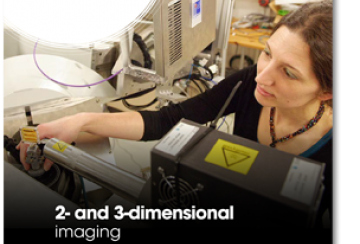Nanoscopium is a unique innovative beamline, which is dedicated to fast scanning multimodal and multi-lengthscale (30 nm à 1µm) X-ray imaging.
It offers simultaneous information in a quantitative manner and in the same experimental conditions, in 2D & 3D (tomography) about the elemental composition, chemical speciation and sample morphology.
The NANOSCOPIUM beamline is open for user proposals

The Nanoscopium hard X-ray (5-20 keV) nanoprobe beamline is dedicated to multi-technique X-ray imaging using fast scanning and high spatial resolution. The beamline develops and offers state-of-the-art X-ray nano-imaging and tomography techniques. Indeed, Nanoscopium offers a large portfolio of complementary imaging and spectroscopy methods, also in association to coherent diffraction imaging techniques. The cutting edge multitechnique possibilities available at the beamline pave the way towards quantitative imaging (morphology, elemental composition and chemical speciation) at hierarchical length-scales (30nm – 1µm).

Multi-lengthscale elemental distribution mapping is available at the beamline
The results shown below are published in "Proceedings of SPIE, X-Ray Nanoimaging: Instruments and Methods III" under paper N° 10389-41


Contacts
|
Andrea Somogyi Proposals, Scientific & Methodological questions |
Office: 01 69 35 96 46, Cell phone: 06 45 47 85 59 andrea.somogyi@synchrotron-soleil.fr |
|---|---|
|
Kadda Medjoubi Proposals, Scientific & Methodological questions |
Office: 01 69 35 96 64 kadda.medjoubi@synchrotron-soleil.fr |
|
Gil Baranton Technical Affairs |
Office: 01 69 35 81 77 gil.baranton@synchrotron-soleil.fr |
Technical data
From 5 KeV to 20 KeV
ΔE/E = 10-4 (Si 111)
Cryo-U18 undulator
White beam
Entrance Optics: Mirrors (vertical and horizontal focusing) for prefocusing and harmonics rejection (Si and Rh coating).
Monochromator: Fixed exit Double Crystal Si(111)
Nanofocusing optics:
- CX3 station:High optical quality Kirkpatrick-Baez (KB) mirror-pair (JTEC), its opto-mechanical system has been provided by Bruker
- CX2 station:Fresnel Zone plates (FZP) developed in collaboration with PSI (Christian David, Laboratory for Micro- and Nanotechnology)
- https://www.synchrotron-soleil.fr/sites/default/files/endnote-pdf/mohacsi-2016-fabrication_and_characterization_.pdf
- https://www.synchrotron-soleil.fr/sites/default/files/endnote-pdf/mohacsi-2015-high_resolution_double-sided_diff.pdf
Multi-technique and multi-lengthscale scanning X-ray imaging and tomography:
Analytical techniques:
- X-Ray Fluorescence Microscopy & tomography
- X-ray Absorption Spectroscopy (XANES) & imaging

- Absorption-, Phase-, and Dark Field contrast imaging & tomography
- Coherent Diffraction Imaging (Ptychography)
Acquisition modes:
- 2D at multiple lengthscales
- 3D by tomography
- Fast continuous sample scanning (FLYSCAN, multi-detector architecture) with down to ms dwell time/pixel
- Network architecture: 10 Gbits tailored to the au high data flux produced by the ensemble of detectors (1 TOctets per day)
Two experimental end-stations, CX2 et CX3, are in exploitation :
CX2 :
- Nano-focusing optics: FZP
- Fast multimodal imaging with high spatial resolution (down to 30 nm by Ptychography)
CX3 :
- Nanofocusing optics: KB (JTEC)
- Fast multimodal imaging with high spatial resolution (70 nm) and high photon flux providing both very high analytical sensitivity and high resolution for elemental and chemical characterisation
CX2 end-station: ~100 x 100 nm2 to 1 x 1 µm2 by FLYSCAN, ~30 x 30 nm2 by Ptychography
CX3 end-station: ~70 x 70 nm2 to 1 x 1 µm2 by FLYSCAN and by step-scan
CX2 end-station: 108-9 ph/s at 15 keV
CX3 end-station: 1010 ph/s at 15 keV
Single element Si Drift Detector (SDD, Ketek)
Multi-element XRF (4 SDD) (RaySpec)
Fats digital multichannel analuser:
- 4-channel FALCON (Xia, inc)
Pixel-detector: EIGER 500K
Pixel-detector: JUNGFRAU 500k
2 X-Ray camera with inderect conversion:
- Scintillateurs + optics with magnifications of (G2, G5, G10) ORCA FLASH
- Scintillateur + optics with magnification of (G4) PCO.Edge
Scientific opportunities
| Earth Sciences & Geobiology | Biocalcification, micro-fossils, paleo-geochemistry, microorganisms in rocks and soils |
|---|---|
| Environmantal Sciences | Pollution, bioremediation, climate proxies, paleoclimatology |
| Biology-Health | Metals in cells/tissues: localisation, (mis-)regulation, accumulation, mineralization, biotechnology |
| Material Science | Microelectronics, energy storage materials, functional devices, nano-structures, dopants, buried structures |
| Cultural Heritage | Art, history, archaeology and conservation science, pigments, ceramics, resins, fibers. |
Proposed 2D &3D imaging modalities
| X-ray Fluorescence Microscopy | elemental composition (identification/quantification of all the elements between sulphur and uranium) |
|---|---|
| X-ray Absorption Spectroscopy | chemical speciation |
| Absorption, phase and dark field contrast | morphology (electron density) |
| Ptychography (coherent diffraction imaging) | high spatial resolution morphology (~35 nm) |




